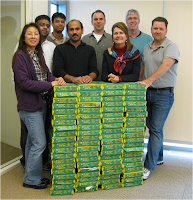To illustrate the “Made to Stick” methodology, this post shares sample messaging that was developed for marketing paper conservation to employees.
Pause Before You Print >>
The “Made to Stick Model” consists of six principles. Each principle is highlighted as encountered in the sample message with the related slides referenced. [Note 2]
1. Principle – Simple (throughout)
Ruthlessly jettison any extra messages to convey a single theme. This presentation focused on printing, but my first draft incorporated a related concept about recycling. Recycling was eliminated since it was tangential to the point of reducing paper use. [Note 3]
Many of us --- with the good intention of getting more benefits from a message --- tend to overload. Unfortunately, too much information is overwhelming and likely to be ignored.
2. Principle – Story (throughout)
This message is in the form of a story about Paul, a co-worker. It follows the standard story formula of creating dramatic tension and then resolving the issue. Most organizations have green enthusiasts in the trenches that have stories to tell. Our job is to find them to make our messages resonate.
3. Principle – Concrete (Slides 2, 4, 13 – 15)
The alliteration “Pause Before You Print” is my attempt at a proverb such as “look before you leap”. The goal is to create a snappy tagline to anchor the entire message and make it easier to recall.
The message starts with a tangible example – an individual’s paper consumption – for a day and then a year before expanding to the entire company. Many of us violate this principle and start spouting statistics about the big problem, because we are already grounded with many examples. We just need to remember to bring the audience along by first framing.
4. Principle – Unexpected (Slides 7 - 8)
“Paper Used Annually …, enough paper that if stacked would reach Mount Everest” This uses a surprising statistic of how quickly a few pages each day when multiplied can lead to a huge amount of paper consumed. This analogy avoids giving the number of sheets, which is a mind-boggling number, but instead illustrates the size using an example from the sensory world.
5. Principle – Emotional (Slides 9 - 12)
The first emotional feature is using Paul to convey the message. Often, employee messages are intoned by a faceless corporate bureaucrat. Later, in the message we engage the target as part of a larger team that can make a difference. Finally, the statistic about what other colleagues have achieved can simultaneously invoke pride and a sense of competition to do as well.
6. Principle – Credible (Slides 13 -14)
The action requested is specific and doable and hence credible. Since this was a sample, I had the liberty to assume that a robust green printing program was already in-place and could then focus the target on using the tools available.
With social marketing, just like any other kind of marketing, it is critical that the customer may easily acquire the product being hyped. If Bud Light were as difficult to acquire as most green behaviors, we’d all be teetotalers. Consequently, it is essential to make it easy to be green. [Note 4]
We, social marketers, are often guilty of breaking this fundamental rule even though we have ample evidence that vague admonishments are likely to fail. If such blandishments were effective, we would be a nation of health-food fans, exercise enthusiasts, saving for a rainy day, and flossing fanatics. But we are not.
To go a step further, we should make the desired behavior automatic (as much as possible) and the remainder easy. Rather than spend a great deal of marketing effort to convince people to print double sided or increase margin’s on documents, as green marketers we should expend our energy on gaining approval to deploy tools and aides that make the desired behavior the default. In the printing case, the supporting tools and infrastructure that should be in-place prior to any messaging are
- Access anywhere, anytime, any device including wireless access in the building
- Document sharing when meeting in person or virtually
- Green templates for different document types that set-up with right-sized margins and fonts
- Double sided printing
In addition to making it easy and automatic, the final step is to make the outcome visible. Without some feedback, it’s easy to forget or fudge the amount of paper being used. Feedback when printing --- such as receiving kudos if doing well or a gentle nudge if falling behind --- will ensure intense employee engagement.
Notes & References
Note 1: Made To Stick is a general business book whose principles are valuable for all sorts of communications. The Made to Stick website inlcudes great resources to get you started. It is worth purchasing the book.
Note 2: Thanks to Peter Graf, CSO and EVP of Sustainability Solutions at SAP for sharing his “Enough Paper to Mount Everest” analogy. He is also a fan of "Made To Stick".
The other parts of the marketing message were created by me for this post to illustrate the “Made To Stick” methodology. Your indulgence of my amateur copy writing is appreciated. Any resemblance to persons or organizations living or dead is purely coincidental.
Note 3: The recycling message. although a worthy goal, was eliminated
Give Paper A Second Chance - Paper has more lives than the proverbial cat. Paper can be recycled up to 12 times and high grade office paper can be made it to almost any other paper product. This will be saved for a subsequent marketing message.
Note 4: Example of typical paper conservation message.
Related Posts
Social Marketing Example: Bottled Water
HP Lives Green - More on change management and employee engagement
Tips on using paper more wisely
Green Goal of Paperless Office Remains Elusive


.jpg)




Great adaptation of general effective communication and influencing principles to a specific example of sustainability.
ReplyDeleteClaudia - nice job showing the application of the book's principles.
ReplyDelete